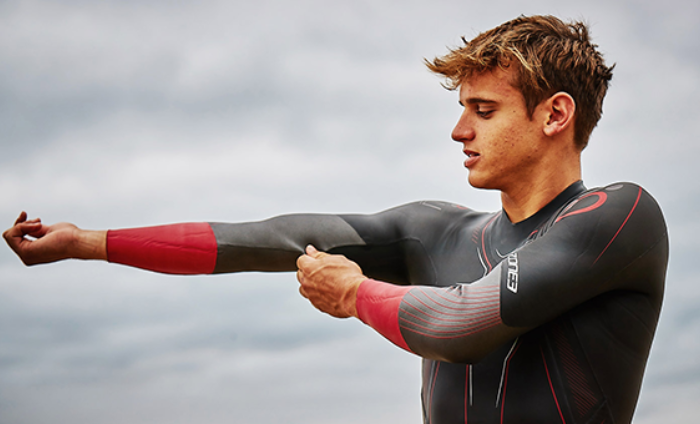
How to choose to right wetsuit for you
One of the most common questions we hear from beginner outdoor swimmers and wild swimmer is: “do I need a wetsuit, and if so, which one?”
To be clear, you don’t need a wetsuit to go swimming outdoors. Many committed ‘skins’ swimmers would argue that swimming in open water without a wetsuit is a more natural experience. In fact, some groups, such as Channel swimming and marathon swimming, actively discourage them. Some swimmers simply don’t find them necessary, or they don’t want the additional faff involved in putting on and taking care of a wetsuit.
On the other hand, there are also reasons why you might want to wear a wetsuit. Their primary purpose is to keep you warmer, which can help you stay comfortable in the water for longer and reduces your risk of hypothermia. Wetsuits are also buoyant and will stop you from sinking. If you need a rest when wearing a wetsuit, you can just roll onto your back and relax. Moreover, a wetsuit can give you some physical protection against cuts and scratches when swimming in natural water environments, where you might bump into sticks or stones, which can be reassuring. Some venues and events also often insist that you wear one.
Buying a wetsuit, though, can be a daunting prospect if you are new to outdoor swimming, especially if you can’t go into a shop and try one one for size. To help you out, here we answer a few of the most frequently asked questions we receive about buying and wearing wetsuits for open water swimming:
How do I choose the right size?
Check the size guides of the brands you’re looking at as there is some variation between them. We’d usually recommend trying before buying at a specialised retailer who can give you expert individual advice. As that’s not possible at the moment, follow the size guides. If in doubt, try to contact the brand directly.
Why does my wetsuit feel so tight?
If you’ve got the right size wetsuit, it will feel tight. It needs to be a snug fit to work properly. If it’s loose, water will pool inside. Make sure you put it on properly. Gently pull the neoprene up on your legs, arms and around your middle to give maximum freedom around your chest, upper back and shoulders. Take some deep breaths on land to reassure yourself you can breathe. Once in the water, it should feel more comfortable.
While a wetsuit might feel tight and uncomfortable when you first put it on, once you get used to swimming in one, it’s snug and secure. The buoyancy makes swimming easier and faster. Sometimes it feels like you’re skating across the water while swimming in one as they tend to lift your body into a more streamlined position. The majority of people swim front crawl significantly faster in a wetsuit than without.
How do I stop chafing?
Chafing usually happens around your neck because of frequently turning your head to breathe, but it can happen anywhere your wetsuit rubs. It’s worse in salt water. Liberal use of wetsuit lube usually does the trick. For severe cases, you could try wearing a rash vest underneath, a silicon collar or that tape physiotherapists sometimes use. Pay attention to the Velcro fastening at the top of your zip to make sure it doesn’t rub, including when lifting your head to breathe.
Can I swim breaststroke in a wetsuit?
Wetsuits are primarily designed to give you an optimal body position for front crawl. As a result, many people find it brings their legs too high in the water for comfortable breaststroke, although it can still be done. If you primarily want to swim breaststroke, consider a breaststroke specific wetsuit or a shortie wetsuit, which has less buoyancy in the legs.
Why do I feel like I can’t breathe when I get
in the water?
If you could breathe in your wetsuit on land, it’s unlikely that the wetsuit is causing you breathing difficulties in the water. It’s more likely to be caused by cold water shock (yes, this can still happen when wearing a wetsuit) or anxiety or nerves about open water. Your breathing should return to normal within one to two minutes. Stay within your depth, float on your back, relax and wait until you feel better before attempting to swim.
How do I put my wetsuit on without help?
There’s no doubt it’s easier to put on a wetsuit if you’ve got someone to help, but that may not be an option in these times of social distancing. The easiest ones to do up on your own are those with a basic bottom to top zip. Those
with a breakaway zip at the top or a reverse (top to bottom) are trickier and require more flexibility and dexterity.
Will any wetsuit do or does it have to be one that’s specific to swimming?
While any wetsuit will keep you warmer, we recommend an open water swimming or triathlon specific wetsuit if your primary activity in it is swimming. Swimming wetsuits are designed to be flexible around the shoulders, soft on the neck (to reduce chafing from turning your head to breathe) and buoyant in the right places to optimise body position in the water.
How much should I expect to pay for a good quality wetsuit?
Prices for a new swimming wetsuit range from less than £200 to more than £500. As you move through the price range, the design changes are primarily intended to improve speed, with more flexibility around the shoulders. However, this flexibility is achieved with thinner and lighter materials and so may be a little less warm and robust. For the recreational swimmer, there are plenty of good value options at the lower end of the market. We take a look at some of these in our guide to the best wetsuits in 2020.







